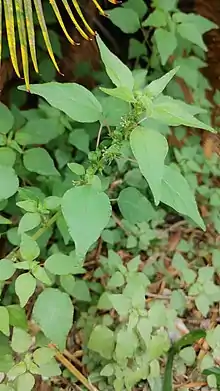Parietaria praetermissa
Parietaria praetermissa, the clustered pellitory,[1] is a plant species native to the coastal plains of the southeastern United States, i.e., Georgia, Florida, Louisiana, North Carolina and South Carolina. It grows in hammocks, waste places, calcareous outcrops, etc., at elevations of 10 m (33 feet).[2]
| Parietaria praetermissa | |
|---|---|
 | |
| Scientific classification | |
| Kingdom: | Plantae |
| Clade: | Tracheophytes |
| Clade: | Angiosperms |
| Clade: | Eudicots |
| Clade: | Rosids |
| Order: | Rosales |
| Family: | Urticaceae |
| Genus: | Parietaria |
| Species: | P. praetermissa |
| Binomial name | |
| Parietaria praetermissa Hinton | |
Parietaria praetermissa is an annual, trailing herb up to 55 cm (22 inches) tall. Leaves are ovate or lancolate, up to 6.5 cm (2.6 inches) long.[3][4][5]
According to Hinton,[3] Parietaria praetermissa was for many years erroneous called Parietaria floridana. However, when Hinton examined the type specimen of P. floridana, he discovered that it was a different species, the only that had been called Parietaria nummularia. Under the rules of botanical nomenclature, this meant that P. nummularia needed to be renamed P. floridana, and the species that had long been called P. floridana was in fact an undescribed species, one which Hinton described as P. praetermissa.
References
- USDA, NRCS (n.d.). "Parietaria praetermissa". The PLANTS Database (plants.usda.gov). Greensboro, North Carolina: National Plant Data Team. Retrieved 14 September 2015.
- Flora of North America v 3
- Hinton, B. D. Sida 3(4): 192–194, f. 1. 1968.
- Godfrey, R. K. & J. W. Wooten. 1981. Aquatic and Wetland Plants of Southeastern United States Dicotyledons 1–944. Univ. Georgia Press, Athens.
- Wunderlin, R. P. 1998. Guide to the Vascular Plants of Florida i–x, 1–806. University Press of Florida, Gainesville.